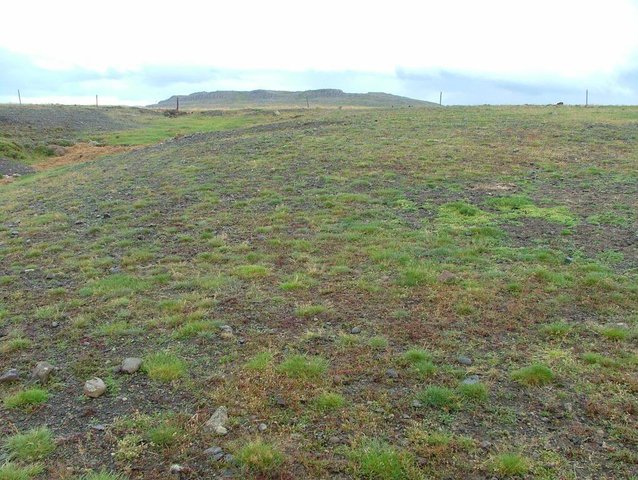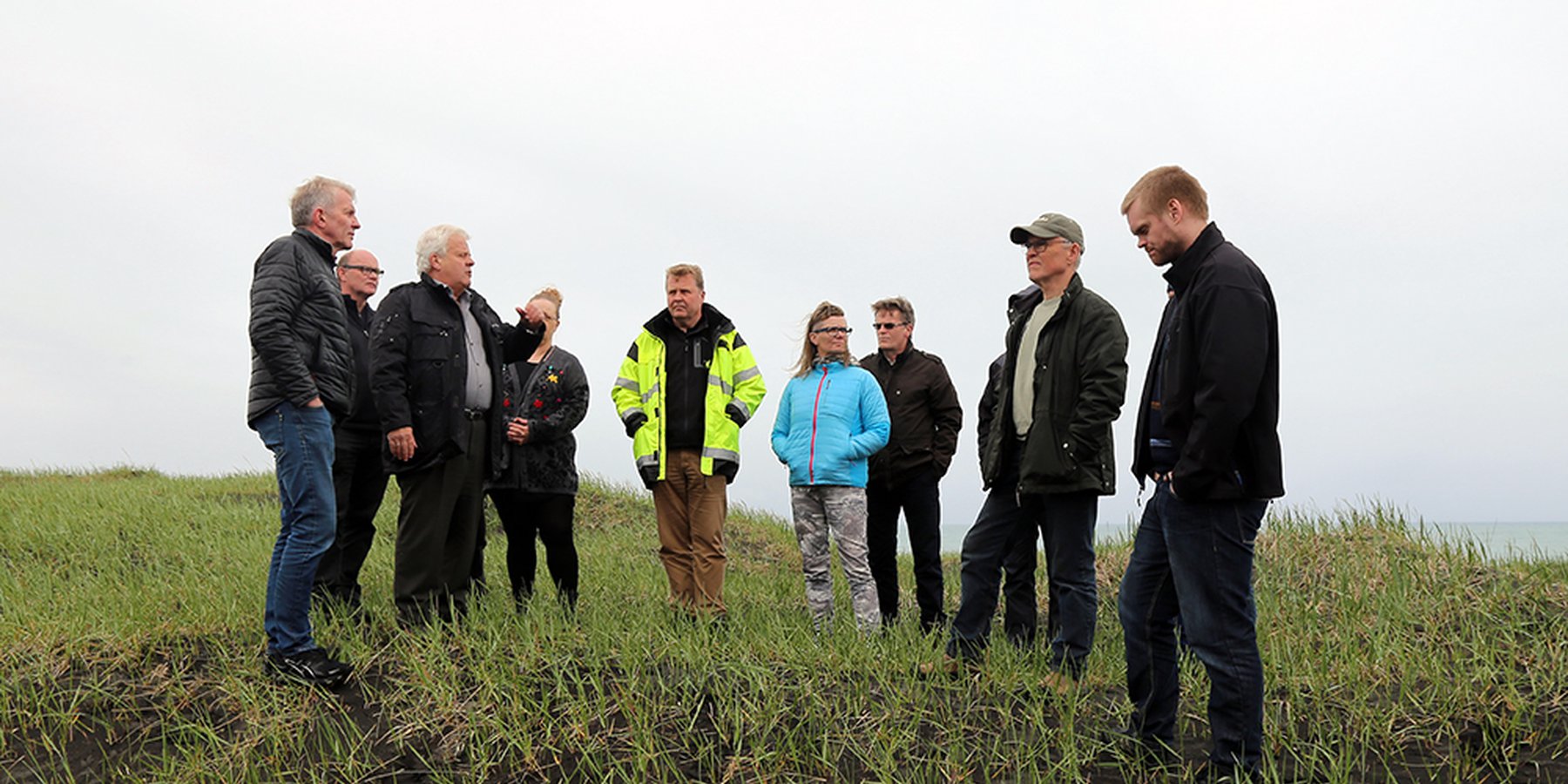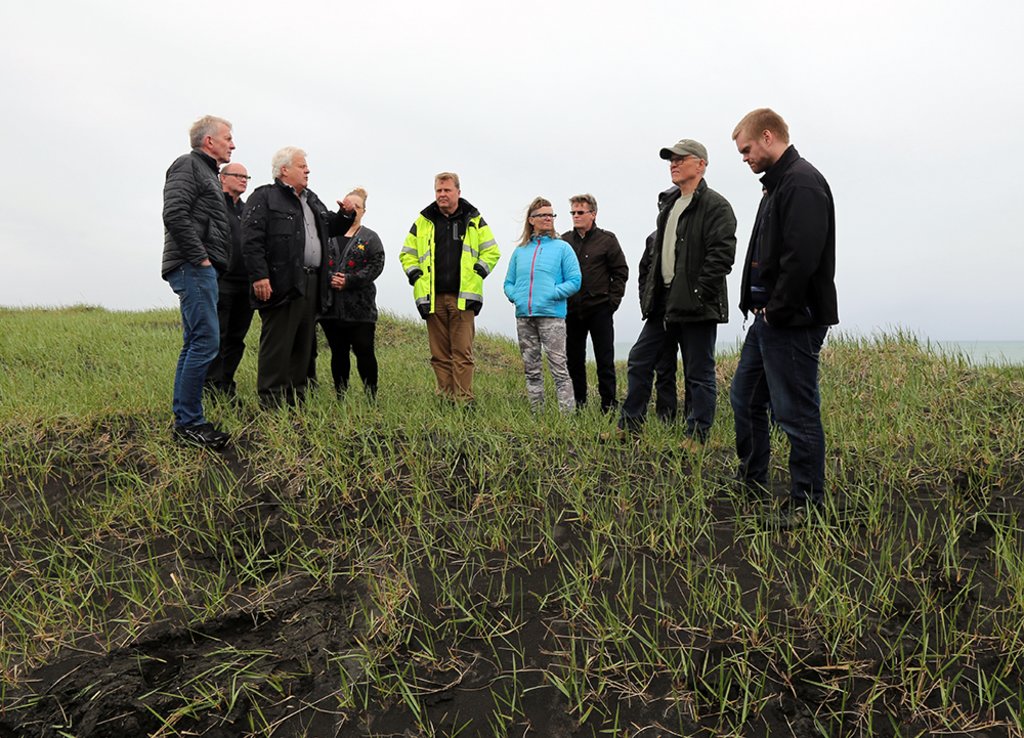Participatory cost-sharing restoration programme [Исландия]
- Создание:
- Обновить:
- Составитель: Thorunn Petursdottir
- Редактор: –
- Рецензенты: Jan Reichert, Hanspeter Liniger
Farmers Heal the Land
approaches_2599 - Исландия
Просмотреть разделы
Развернуть все Свернуть все1. Общая информация
1.2 Контактные данные специалистов и организаций, участвующих в описании и оценке Подхода
Название организации (-ий), содействовавших документированию/оценке Подхода (если применимо)
Soil Conservation Service of Iceland (Soil Conservation Service of Iceland) - Исландия1.3 Условия, регламентирующие использование собранных ВОКАТ данных
Составитель и ответственный/-ые специалист(-ы) согласны с условиями, регламентирующими использование собранных ВОКАТ данных:
Да
1.4 Ссылка (-и) на Анкету (-ы) по Технологиям УЗП

Fertilizing and re-seeding degraded rangelands [Исландия]
Rangeland restoration - Spreading small portions of inorganic fertilizer and seeds on degraded rangelands
- Составитель: Thorunn Petursdottir
2. Описание Подхода УЗП
2.1 Краткое описание Подхода
Collaboration between farmers and a governmental institute on rangeland restoration and improved land management
2.2 Подробное описание Подхода
Подробное описание Подхода:
Aims / objectives: FHL is a governmental cost-sharing programme operated by the SCSI and run at national level. The FHL programme has been ongoing since 1990. It started as an experimental programme in Northeast Iceland, but couple of years later it was extended nationwide. It builds on voluntary participation of farmers who want to restore damaged rangelands in the lowland. The programme was established foremost to ease cooperation and strengthen social bonds between the SCSI and sheep farmers. Nevertheless, increased rangeland restoration and improved grazing management were also key targets underpinning the establishment of the FHL initiative, and formed the backbone of its prime policy.
Methods: The FHL programme is run by the Soil Conservation Service of Iceland (SCSI) and targets large-scale rangeland restoration, primarily among sheep farmers. The programme builds on voluntary approaches and uses direct and indirect incentives to motivate its participants. Farmers who want to participate apply for membership of the SCSI. The SCSI evaluates the condition of potential restoration areas and decides if they meet requirements. Each participant receives, annually, a fixed subsidy to purchase fertilizer and if needed, commercial grass seeds. Participants in the FHL project are visited approximately biannually by a regional SCSI advisor that estimates the restoration progress, discusses next steps and consults the participants on rangeland management related issues. Usually, each restoration area is treated for a couple of years before it is considered to have passed the first level of the restoration process. The restoration areas are mapped, and based on the maps participants asked to make a 3-5 year long implementation plan.
Role of stakeholders: As land stewardship plays a vital role in this programme, the role of the primary stakeholders (the farmers) is fundamental. They indeed drive the programme, although they get professional guidance and support from the extension offices of the SCSI. They are responsible for all implementation and land management on a local scale, within their own holdings.
Other important information: no further information
2.3 Фотографии, иллюстрирующие Подход
2.5 Страна/ регион/ место, где применялся Подход
Страна:
Исландия
Административная единица (Район/Область):
Rangarthing Ytra
Более точная привязка места:
Rangarvellir
2.6 Даты начала и окончания реализации Подхода
Год начала реализации:
1990
2.7 Тип Подхода
- недавняя местная инициатива/ инновация
2.8 Каковы цели/ задачи Подхода
The Approach focused mainly on SLM with other activities (rangeland restoration, sustainable land management, participatory approaches, stakeholder involvement)
To improve the ecological condition of the degraded rangelands for future generations. To facilitate behavioral changes toward more sustainable rangeland management.
The SLM Approach addressed the following problems: The main problems to be addressed by the approach were severe soil and vegetation degradation that substantially reduced biomass productivity, lack of financial support and local advisory system
2.9 Условия содействующие применению Технологии/ Технологий в рамках Подхода или затрудняющие его
Социальные/ культурные/ религиозные нормы и ценности
- затрудняют
Treatment through the SLM Approach:
Наличие/ доступность финансовых ресурсов и услуг
- затрудняют
the approach provides subsidies to participants
Treatment through the SLM Approach:
Институциональные условия
- затрудняют
Establishment of extension offices that provide advisory service on restoration and SLM technologies and approaches, free of charge to all land users.
Treatment through the SLM Approach:
Нормативно-правовая база (землевладение, права на земле- и водопользование)
- затрудняют
Treatment through the SLM Approach:
Осведомленность в области УЗП, доступность технической поддержки
- затрудняют
Establishment of extension offices that provide advisory service on restoration and SLM technologies and approaches, free of charge to all land users.
Treatment through the SLM Approach:
Объем работ, доступность рабочей силы
- затрудняют
Treatment through the SLM Approach:
3. Участие и распределение ролей заинтересованных сторон
3.1 Заинтересованные стороны, участвующие в реализации Подхода и их роли
- местные землепользователи/ местные сообщества
Main actors - voluntary work, mostly at their own expenses
- эксперты по УЗП/ сельскому хозяйству
- местные власти
Provide small scale funding
- государственные власти (отвечающие за планирование или принятие решений)
Main funding contributor - advisory system - local support
- международные организации
3.2 Участие местных землепользователей/ местных сообществ на разных стадиях реализации Подхода
| Участие местных землепользователей/ местных сообществ | Перечислите участников и опишите их вовлеченность | |
|---|---|---|
| инициирование/ мотивация | самоорганизация | |
| планирование | интерактивное | |
| выполнение | самоорганизация | |
| мониторинг/ оценка | пассивное | |
| Research | нет |
3.4 Принятие решений по выбору Технологии/ Технологий УЗП
Укажите, кто принимал решение по выбору применяемой Технологии/ Технологий:
- преимущественно специалисты по УЗП после консультаций с землепользователями
Поясните:
Decisions on the method of implementing the SLM Technology were made by mainly by land users supported by SLM specialists
4. Техническая поддержка, повышение компетенций и управление знаниями
4.1 Повышение компетенций/ обучение
Проводилось ли обучение землепользователей/ других заинтересованных лиц?
Да
Укажите, кто проходил обучение:
- землепользователи
- местный персонал/консультанты
- Researchers
Тип обучения:
- в ходе работы
- обмен опытом между фермерами
- опытные участки
- общие собрания
- курсы
Тип обучения:
- local advisors that visit/contact all participants
Рассматриваемые темы:
E.g. the role of ecosystem services for human well-being, ecosystem resilience and natural hazards, the importance of proper grazing management and the importance of merging local and external knowledge to secure more effective long-term social-ecological progress.
4.2 Консультационные услуги
Есть ли у землепользователей возможность получать консультации?
Да
Описание/ комментарий:
Advisory service is very adequate to ensure the continuation of land conservation activities
4.4 Мониторинг и оценка
Являются ли мониторинг и оценка частью Подхода?
Да
Комментарии:
bio-physical aspects were regular monitored by project staff through observations; indicators: visual estimation
bio-physical aspects were ad hoc monitored by other through measurements; indicators: Researchers of the SCSI
technical aspects were ad hoc monitored by project staff through observations; indicators: Researchers in collaboration with the SCSI
socio-cultural aspects were ad hoc monitored by other through measurements; indicators: Researchers in collaboration with the SCSI
economic / production aspects were ad hoc monitored by other through observations
area treated aspects were monitored by project staff through observations
There were no changes in the Approach as a result of monitoring and evaluation
There were few changes in the Technology as a result of monitoring and evaluation: Reduced amount of fertilizer and seed when restoration areas are treated
4.5 Научные исследования
Были ли научные исследования частью Подхода?
Да
Укажите темы исследований:
- социология
- экология
Напишите подробнее и назовите тех, кто выполнял исследования:
Research was carried out both on station and on-farm
5. Финансирование и внешняя материальная поддержка
5.1 Годовой бюджет мероприятий по УЗП в рамках Подхода
Если точный годовой бюжет неизвестен, укажите примерный диапазон затрат:
- 100 000-1 000 000
Комментарий (например, основные источники финансирования/ ключевые доноры):
Approach costs were met by the following donors: government: 78.0%; local government (district, county, municipality, village etc): 2.0%; local community / land user(s): 20.0%
5.2 Финансирование и внешняя материальная поддержка, предоставляемая землепользователям
Предоставлялась ли землепользователям финансовая/ материальная поддержка для применения Технологии /Технологий?
Да
5.3 Субсидии на отдельные затраты (включая оплату труда)
- сельскохозяйственные
| Укажите, какие ресурсы были субсидированы | В какой степени | Опишите субсидии подробнее |
|---|---|---|
| удобрения | профинансированы частично | Up to 85% of the cost of the fertilizer |
Если труд землепользователя был существенным вкладом, укажите, был ли этот вклад:
- добровольный
Комментарии:
Voluntary but also subsidies for purchasing inorganic fertilizer
6. Анализ влияния и заключительные положения
6.1 Влияние Подхода
Сумел ли Подход помочь землепользователям внедрить и поддерживать технологии УЗП?
- Нет
- Да, немного
- Да, умеренно
- Да, существенно
Did other land users / projects adopt the Approach?
- Нет
- Да, немного
- Да, умеренно
- Да, существенно
Did the Approach lead to improved livelihoods / human well-being?
- Нет
- Да, немного
- Да, умеренно
- Да, существенно
6.2 Основные причины, побуждающие землепользователей внедрять УЗП
- рост продуктивности
- рост прибыли (доходности) и рентабельности
- материальное стимулирование/ субсидии
- нормативно-правовое регулирование (штрафы)/ контроль
- престиж, общественное давление/ солидарность
- причастность к движению/ проекту/ группе/ сети
- экологическая сознательность
- улучшение эстетической привлекательности
- well-being and livelihoods improvement
6.3 Долгосрочная устойчивость мероприятий в рамках Подхода
Могут ли землепользователи самостоятельно (без внешней поддержки) продолжать применение того, что было реализовано в рамках Подхода?
- да
6.4 Сильные стороны/ преимущества Подхода
| Сильные стороны/ преимущества/ возможности по мнению составителя или других ключевых специалистов |
|---|
| Builds up trust between farmers and governmental officials. Awareness raising and can facilitate discussions on improved rangeland management |
6.5 Слабые стороны/ недостатки Подхода и пути их преодоления
| Слабые стороны/ недостатки/ риски по мнению составителя или ответственных специалистов | Возможные пути их преодоления/снижения? |
|---|---|
| governement pays the most | awareness rising farmers to restore the land |
| government has to trust that the farmer is doing the job | checking in the field (but number of used material difficult to count afterwards und the right time in the spring) |
7. Справочные материалы и ссылки
7.1 Методы сбора/источники информации
- выезды на места, полевые обследования
- опросы землепользователей
Ссылки и модули
Развернуть все Свернуть всеСсылки

Fertilizing and re-seeding degraded rangelands [Исландия]
Rangeland restoration - Spreading small portions of inorganic fertilizer and seeds on degraded rangelands
- Составитель: Thorunn Petursdottir
Модули
Нет модулей



